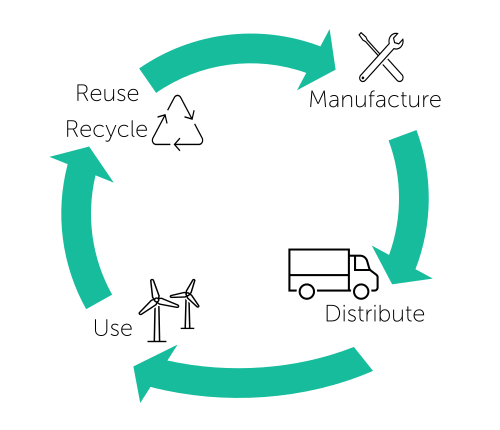Article contents
▸
Article
Tessa Axsom
08.04.2023 Supply Chain Management
The global supply chain is rapidly evolving, trying to keep up with the dizzying technological advancements of the modern era. Read on to learn about the latest supply chain innovations in 2023 and beyond.
Artificial intelligence (AI) is more popular than ever. Our 2023 State of Manufacturing Report shows that 85% of companies surveyed have already adopted AI solutions, and 45% anticipate impacts to supply chain management functions.
ACCESS OUR STATE OF MANUFACTURING REPORT
AI and automation are valuable tools that can speed up your supply chain and help you remain competitive in your niche. And whether or not you use AI, you should be streamlining your supply chain because your competitors are streamlining theirs. Our report shows that 97% expect AI to impact product development and manufacturing.
From improving your assembly line to powering digital twin technology and everything in between, there are many ways to incorporate AI and automation into your organization’s workflow. For supply chain management processes, consider using AI for
55% of those surveyed in our 2023 State of Manufacturing Report said they were looking at supply chain visibility as their top business priority.
Pro-Tip: You can automate your supply chain by outsourcing part procurement to a digital manufacturing company like Fictiv. Our intelligent platform utilizes AI for free, instant design for manufacturability (DFM) feedback, and manufacturing partner sourcing (so you don’t have to chase down suppliers via email).
Companies face barriers to new product introduction (NPI) due to economic uncertainty, inflation, and geopolitical instability. 94% face barriers to NPI and 49% have a focus on increasing NPI speed, per our latest State of Manufacturing Report.
This increase in demand for faster NPI means that companies must shift to higher-performing and more resilient supply chains to maintain rapid prototyping and innovation.
Partnering with a supplier equipped with AI-powered supply chain sourcing technologies ensures a robust supply chain, supports rapid prototyping, and enables faster time to market.
Moreover, early-stage collaboration between procurement and supply chain management teams can provide valuable insights into material selection and identify potential supply chain issues.
To stay competitive in 2023 and beyond, businesses must segment their supply chain and create customized strategies for each segment.
Consider customizing your manufacturing services, such as CNC machining and injection molding, to build prototypes and accelerate production without sacrificing quality or precision.
To simplify managing personalized customer orders, automate your order processing system by separating standard orders from customized ones.
For hassle-free custom manufacturing, check out Fictiv. We offer fast, efficient, and precise custom-manufactured parts right when you need them, and we handle the entire supply chain for you!
The Internet of Things (IoT) refers to a network of physical objects that are digitally connected and accessible from anywhere via a wireless network. Based on research conducted by Dataprot, there will be more than 25.4 billion IoT devices in operation by 2030.
In addition to providing more oversight in operations and transportation, IoT can improve:
The value of the IoT cannot be overstated, and it’s not going away. According to McKinsey Digital, 127 devices connect to the internet for the first time every second. 54% of those surveyed in our 2023 State of Manufacturing Report already use, and another 33% are implementing, Industrial IoT (IIoT) digital manufacturing technologies.
IoT devices can be used with other pieces of technology for even greater benefit. For instance, the information collected by a sensor in your warehouses could provide valuable data that helps you automate other processes, such as forecasting and asset tracking.
Interested in learning more about how today’s manufacturing environment is impacted by IoT, digitization, and AI? Download the full 2023 State of Manufacturing Report here.
Businesses can drive their bottom line by creating digital manufacturing ecosystems. This trend is particularly relevant to e-SCM, or Electronic Supply Chain Management.
Recent research showed that 60% of respondents already use, and 31% are implementing, digital supply chain analytics and visualization platforms.
Here are some key benefits of digitizing your supply chain:
A recent study shows that 71% of companies want to increase their U.S.-based manufacturing, and over half want to expand their North American supplier base.
However, these companies want to partner with suppliers who are committed to building long-term relationships. Maintaining strong relationships with your team members, vendors, and suppliers can increase collaboration and cooperation at every stage of the supply chain.
Pro tip: Find a digital manufacturing partner that prioritizes the value of people and their unique problem-solving abilities. This approach ensures a thorough inspection process that provides high-quality parts at an impressive speed and endless customization options.
Also, look for mutually beneficial ways to support your and your supplier’s goals. Share information, proactively solve problems to avoid creating more work, and address unexpected issues as they arise.
It’s your responsibility to mitigate risk as much as possible so your supply chain remains stable during uncertain times.
For example, if you source raw materials from a politically volatile area, look into sourcing that material from a more stable geographic area. Should anything change, you can pivot quickly and minimize the impact of that disruption. Here are the top ways companies are looking to reduce supply chain risk in 2023:
Improving supply chain visibility has been the top business priority for leaders (55% per our latest State of Manufacturing Report) for two years in a row.
However:
One of the most common tools for supply chain visibility is supply chain management technology, which includes IoT, 5G and Starlink networks, AI, machine learning, robotics, and PLM (Product Lifecycle Management) software.
With more visibility in your supply chain, you can:
Pro tip: Check out our ebook, Modern Supply Chain Management!
Also, check out our post on 30+ Supply Chain Statistics you should know!
There is now a growing belief in the circular supply chain process concept which involves recycling raw materials and even discarded products to reintroduce them into manufacturing.
The circular supply chain model certainly helps with sustainability efforts, but it also provides economic benefits for your organization. You stand to save more money on reduced storage, transportation, and administrative costs, too.
Additionally, with the right technological solutions, you can stay updated on the current state of your materials and products in real-time.
Companies like yours (78% of respondents) are already evaluating technology solutions to increase operational efficiency for new product development.
Software-as-a-Service (SaaS) models are beneficial for supply chain management. Not only is SaaS reliable and secure, but it’s highly efficient and convenient. With a global and digital supply chain, the efficiency of SaaS solutions is crucial.
As these trends evolve, so will the art of supply chain management. Click here to learn more about cloud-based solutions, stay up-to-date, and position your organization for success.
These current trends in supply chain management can also be useful tools to strengthen your supply chain and make it more agile and resilient. Technology integration is the key to future supply chain success, which is why so many firms are digitally transforming their operations. Here are the core concepts to remember as you do the same:
If you’re tasked with sourcing and supplying mechanical parts, regardless of the type of machining or product development services you need, Fictiv makes it faster, easier, and more efficient to source and supply quality, complex mechanical parts. Head to Fictiv.com to learn more about our services that simplify your supply chain, then create an account and upload your designs to get an instant quote and free DFM feedback today!
For further learning, check out these Fictiv resources:
By signing up, you agree to our Terms of Use and Privacy Policy. We may use the info you submit to contact you and use data from third parties to personalize your experience.




